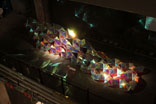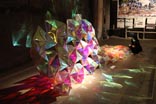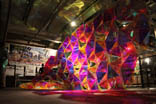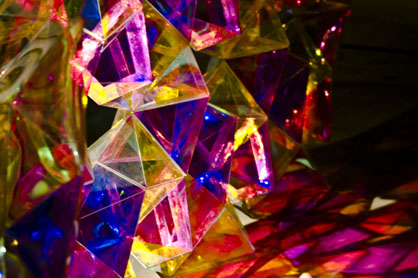| home > files |
| (Way) Beyond Dora Epstein Jones |
||||
| Dora Epstein observes the work of Elena Manferdini and Alexis Rochas, instructors at SCI-Arc. In particular she looks at the VISIONS WALL installation, described in ARCH'IT architetture, designed and built on the occasion of the ninth edition of the BEYOND MEDIA festival, as a cue for reflection. A continuity between experimentation and design, between research and formal control are at the center of Alexis's and Elena's didactic activity which allows the students to keep innovating and tuning in with the new digital researches in architecture. [PG] |
||||
| In our small community at SCI-Arc, Elena Manferdini and Alexis Rochas are known for 3 main things: 1. their ability to transform everyday materials into expressive, lyrical works of geometric complexity; 2. the seamlessness with which they then apply these arts to solve architectural problems such as massing, skinning, and baffling; and, 3. their relentless demand for rigor from our students. Typically, the students may moan and whine over the long hours, the persistent demands, of studio work under these two instructors. Atypical are the students who have actually volunteered their time and efforts to collaborate with Elena Manferdini and Alexis Rochas on this Visions Wall installation. "Beyond" is mostly an understatement. And yet, in all cases, the students will learn the valuable lesson of connecting the "working with" with the "working through," as both shape and material primitives (sticks, felt, cardboard) undergo unexpected and beautiful transformations and deformations. The students discover that this is no mere magic trick. The process is neither easy nor guaranteed. Indeed, to produce such work is extremely challenging in all senses of the word. |
[22 novembre 2009] |
|||
   The Vision Wall installation in Florence. A SCI-Arc installation by instructors Elena Manferdini and Alexis Rochas made for the BEYOND MEDIA festival (SPOT ON SCHOOLS exhibition curated by Paola Giaconia). |
 First (in the beginning of the process), there is the work that is done on the computer. In an age when the computer was imagined to be a time-saver, it is for both Manferdini and Rochas, merely one (super-complex) step in a (hyper) complex process. Visualization alone is not enough for these young design educators: instead they run scripts, racing different algorithms against each other to provoke catastrophic deformations. Then, instead of settling for a planar image from which to extrapolate architectural norms of say, plans and sections – they push these algorithms into the third dimension, forcing the math to do what it has always desired but also has always resisted. From algebra into space, geometry into form, even the computer is asked to perform above and beyond expectations – asking from it, demanding from it, the impossible task to both follow rule sets as well as produce deformations. In their collaboration, "Beyond Media," this protracted visualization is referred to simply as "anchoring," but the Escher-like drawings tell a different story. Irregularities are counter-point to the ready perception of the regularities, instantiating a non-semiotic, and entirely new, "reading" of figure and ground. It is highly visual and intense – and probably not at all what was intended for this software. Second (step two?), there is the process of materialization. If we do accept that intense geometric visualization is a challenging goal, so we are also still in a moment when extreme geometries may seem enough to satisfy a need for architectural experimentation. It is not uncommon therefore to see whole projects visualized through the computer without any sense of how it might be built. However, for both Manferdini and Rochas (and hence expected from all of their students), complex geometric visualization via the computer is one of many tools, one of the many steps, towards realization, or to be more precise, towards materialization. In fact, while virtual modeling can be an acceptable end result for many, these instructors see it as a kind of "testing ground" for possible manipulations that can be readily applied to the material of choice. This is where both Manferdini and Rochas break from their design counterparts, break from the new norms established by visualization, to take a direct, hands-on approach. A casual stroll through their design studios is actually a difficult traversing of stuff – bits of discarded cardboard, random folds of felt or crepe, and sticks, well, everywhere – as they translate the visual into the dimensional. They truly experiment with the material, watching and testing its properties within the arrays established by the computer, as well as other mediums for drawing and representation. There is no word for this yet, but perhaps "composition studies" will do, insofar as a composition is not merely something that is visually-pleasing, but is also composed of parts. Because of the influence of the computer, however, these are not Cartesian parts – again, there is that implicit critique of the semiotic- in the reading that can't be read. We see parts, but there is no whole. We see a composition but there is no end to it. Finally (a very involved step three), there is the process of construction. Architectural experimentation is slowly but surely waking up to the real problems of construction. Whole schools are dedicating themselves to BIM, CATIA and other (very expensive) means because this is now imagined to be the near-future crux of contemporary architecture. It is probably important to note our experimentation to this end runs the risk of becoming an architectural "exquisite corpse," as it seems that every studio is producing a particular specialist – one is structure, another in skin, and so on. But, because every move along the path of a process led by Manferdini and Rochas anticipates its eventual fabrication, there is a pronounced tectonic fitness in each of their projects – cuts in felt reveal envelope-driven spaces, plastics can be interlocked to form cells, and so on. It is yet unanswered what these designers will do with competing material tectonics, but that may be more of a fact of the technological limits of the computer than any fault of their own. In other words, if anyone will make the computer recognize the potential collisions between the tectonic mandates of different materials, it will probably be these two. And, years hence, when we think of Manferdini cutting crepe in a shop with a laser, or Rochas having to scale triangulation based on available widths of off-the-shelf aluminum tubing, or we reflect on how revolutionary it once seemed to enlist student intelligence to work through material deformations (now done in the blink of an eye), we might smile and wonder at these aboriginal extremes; but it will probably also feel like a form of early research. And that idea, "research," is in itself still radical and still foreign to our discipline. |
|||
| In many ways, our discipline (and to say, discipline does invoke the problem) is still mired in a rather Humanist belief that art and science are separate but aligned ontological entities; and that, even if architecture is thought to bridge the gap between the two, ala the Bauhaus, the distinctions must still be maintained or at least recognizable. Therefore, while there have been many claims to the word "research" in architecture, especially over the last ten years, it has been decidedly difficult to figure out what that really means. For some, it remains a technical term – the research of the engineer who tests different materials and their properties as well as different methods and their outcomes according to the dictums of sound scientific research. For others, it is a more social possibility, using new manifolds of data sets, especially spatial ones, to drive different social hypotheses, that may or may not be tested per se, but are capable of driving radically-different design approaches to socially-tinged problems. It is rarely an aesthetic exercise though – and therein lies that seemingly eternal rub between knowledge categories. The difference here, with "Beyond Media" as well as other individual projects by these designers, is that they don't merely visualize and then figure out how to build. They subject their work to all kinds of tasks – rule sets, number limits, strenuous mathematics and specific architectural expectations. On top of that, they invite collaboration, invite the intelligence borne from multiplicity – Rochas collaborates with Manferdini as design instructors, and they in turn collaborate with their students to discover forms, compositions and material behaviors – far more like a research team than a classic design studio. Then (as if that weren't enough), with only the audacity that youth possess, they do not accept inelegance. There will be naysayers – those who prefer to make poetry from the simplest of gestures – dragging a stick on the sand, piling up rocks and debris – many who will absolutely refuse to imagine all of the steps, all of the pain, that both Manferdini and Rochas expect from their process. Process is supposed to make things easier! Process is supposed to guarantee fast results! This process is difficult, harrowing, subject to a scientific level of proof, hinged on the factness of material, tested against the integrities of tectonic construction, ...and utterly, exquisitely beautiful ...beyond words. But, ugh! - the pedagogical, and hence design, world of these educators is founded on, and reinforced continually, by this scientific/aesthetic rigor. The fact is that many students dread the thought of studio classes with Manferdini or Rochas. They see their predecessors working far longer hours than they – not just in the computer lab, but also in the shop and at their desks, constantly manipulating, folding, pushing materials beyond., way beyond – and they think "I can't do that." And, then the day comes when they do take studio with Manferdini or Rochas, and they do. Dora Epstein Jones |
||||
| Dora Epstein Jones, Ph.D., is a theorist and teacher of architectural culture. Her work mainly focuses on the discipline of architecture, and includes interrogations on the discipline¹s boundaries and operations through examinations of tectonics, practice and pedagogy, as well as (generally external) concerns such as gender, sex, mobility and criticality. Dr. Jones is a long-time collaborator with Jones, Partners: Architecture. She currently divides her time between writing, teaching at the Southern California Institute of Architecture, and raising her young son. | ||||
| >
ARCHITETTURE: MANFERDINI, ROCHAS. VISION WALL |
||||
|
||||
Per
qualsiasi comunicazione laboratorio
|